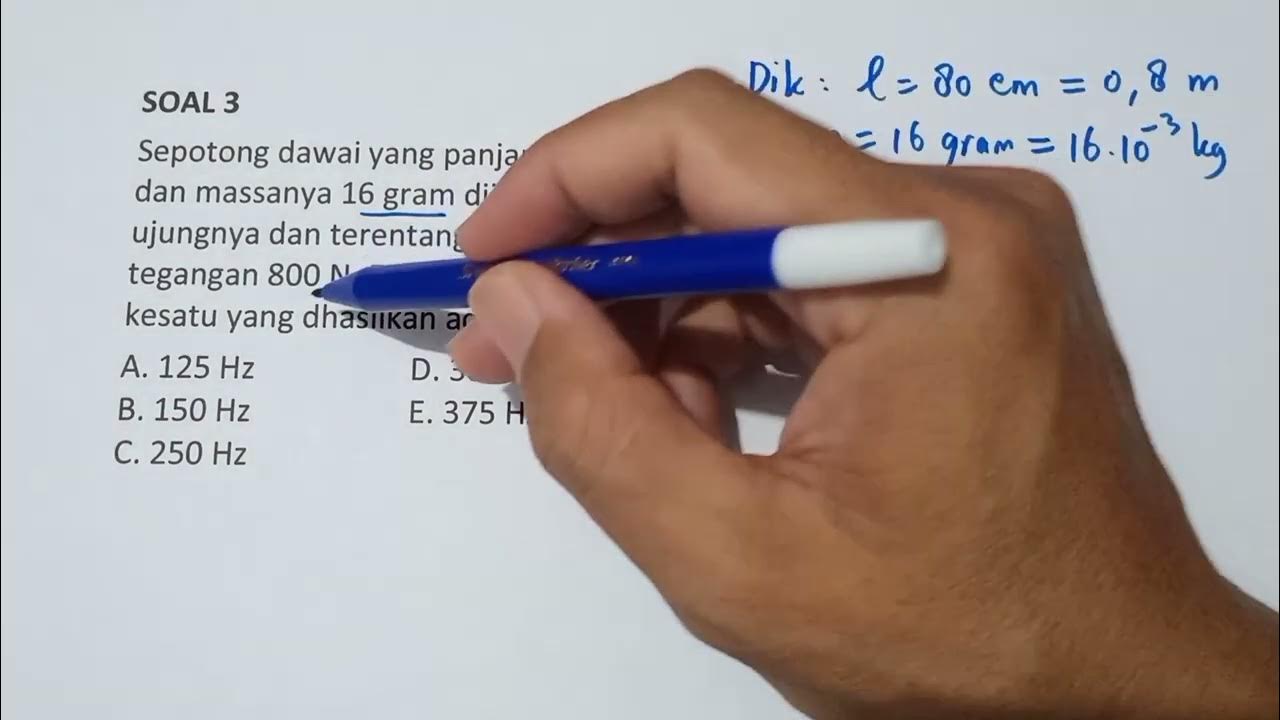Percobaan Melde - Menentukan Cepar Rambat Gelombang Pada Tali
Summary
TLDRThis educational video covers the Melde Experiment, exploring the relationship between the speed of wave propagation on a string and factors like tension, mass, and length of the string. The experiment demonstrates how wave speed is proportional to the square root of the tension and inversely proportional to the square root of the mass per unit length of the string. The setup includes a string fixed at one end with a mass hanging at the other, and the video explains the resulting transverse waves and their connection to stationary waves. The theory and calculations related to wave speed and tension are also discussed.
Takeaways
- 😀 The lesson focuses on wave phenomena, specifically the waves on a string or cord, with the Melde experiment as the main topic.
- 😀 The Melde experiment investigates the relationship between wave speed on a string and factors such as the tension, mass, and length of the string.
- 😀 The experiment demonstrates that the wave speed is directly proportional to the square root of the tension and inversely proportional to the square root of the mass per unit length of the string.
- 😀 The experimental setup involves tying a string at one end and attaching a hanging weight at the other end, with the string having a specific length and mass.
- 😀 When the string is vibrated, transverse waves are generated, and the setup allows the formation of standing waves, similar to the concept of wave reflection at a fixed end.
- 😀 The weight creates a downward force (gravitational force), and this force leads to tension in the string, which is counteracted by the tension force in the opposite direction.
- 😀 The tension force is symbolized by 'T' and is balanced against the gravitational force acting on the weight.
- 😀 The formula for wave speed on the string is given as V = √(F/m/l), where 'F' is the tension, 'm' is the mass of the string, and 'l' is the length of the string.
- 😀 The tension force 'F' is equivalent to the weight of the hanging mass, which is the product of the mass and the acceleration due to gravity.
- 😀 The experiment verifies the relationship between wave speed and the tension, mass, and length of the string, providing a clear understanding of wave dynamics in this context.
Q & A
What is the main topic of the experiment discussed in the script?
-The main topic of the experiment is Melde's experiment, which investigates the relationship between the wave velocity on a string, the tension in the string, the mass of the string, and the length of the string.
What is the purpose of Melde's experiment?
-The purpose of Melde's experiment is to examine the relationship between the wave speed on a string and the tension, mass per unit length, and length of the string.
How does the experiment demonstrate the wave speed on a string?
-The experiment demonstrates that the wave speed on the string is proportional to the square root of the tension in the string and inversely proportional to the square root of the mass per unit length of the string.
What are the key components used in the Melde experiment?
-The key components of the Melde experiment include a string (or wire), a fixed point (like a pulley), a hanging mass, and a mechanism to create vibrations in the string.
How is the tension in the string related to the hanging mass?
-The tension in the string is equal to the weight of the hanging mass, which is the mass of the weight multiplied by the acceleration due to gravity.
What type of wave is created when the string is vibrated?
-When the string is vibrated, a transverse wave is created, which is a type of wave where the oscillations occur perpendicular to the direction of the wave's travel.
What happens at the fixed end of the string during the experiment?
-At the fixed end of the string, the wave is reflected, creating a stationary wave pattern, which is similar to the study of standing waves.
How is the speed of the wave on the string calculated?
-The speed of the wave on the string is calculated using the formula V = √(T / (μ)), where V is the wave speed, T is the tension in the string, and μ is the mass per unit length of the string.
What does the symbol 'μ' represent in the formula for wave speed?
-'μ' represents the mass per unit length of the string, which is the mass of the string divided by its length.
What does the result of Melde's experiment prove regarding wave speed?
-The result of Melde's experiment proves that the wave speed on a string is directly proportional to the square root of the tension in the string and inversely proportional to the square root of the string's mass per unit length.
Outlines

This section is available to paid users only. Please upgrade to access this part.
Upgrade NowMindmap

This section is available to paid users only. Please upgrade to access this part.
Upgrade NowKeywords

This section is available to paid users only. Please upgrade to access this part.
Upgrade NowHighlights

This section is available to paid users only. Please upgrade to access this part.
Upgrade NowTranscripts

This section is available to paid users only. Please upgrade to access this part.
Upgrade NowBrowse More Related Video

Gelombang Bunyi • Part 2: Contoh Soal Cepat Rambat Gelombang Bunyi

Transverse Wave on a String | Engineering Physics | S Chand Academy

Percobaan Eksperimen Melde | Praktikum Fisika Dasar 1 | UPT Laboratorium Terpadu UHO

Mudah Mengerjakan Soal Gelombang Dawai || Fisika Kelas XI || #oprekmafiki #fisikasma #fisikaasyik

Boundary Conditions

Wavespeed - GCSE Science Required Practical
5.0 / 5 (0 votes)